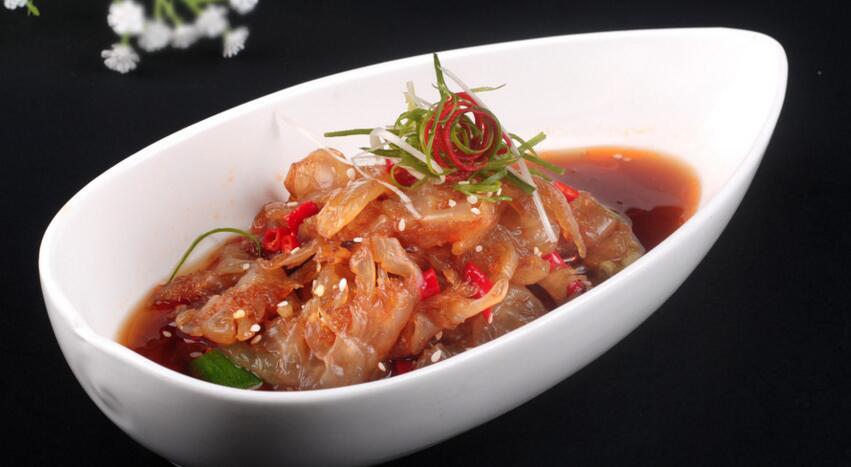Well prepared, the delicacy is a tactile delight, with a toothsomeness seldom found in other foods, Pauline D Loh writes.
You would not want to meet a jellyfish while swimming in the sea, and some would definitely balk at a close encounter with this creature on the dining table.
But not the Chinese, who have effectively reduced the jellyfish, despite its fearsome reputation, to nothing more than a crispy crunchy delicacy popular as an appetizer.
Well prepared, the jellyfish is a tactile delight, with a toothsomeness seldom found in other foods. Those who love it describe the texture as smooth, crisp, crunchy and bouncy.
Others think it tastes like rubber bands.

Not all jellyfish are edible, of course, and even the voracious Chinese would leave the fearsome Portuguese man-ofwar pretty much alone. But the variety of sand jellyfish (rhopilema esculenta Kishinouye) abundant in Bohai, off the northeastern coast of China, is eagerly harvested, processed and eaten in both China, the Korean Peninsula and Japan.
The jellyfish is harvested and quickly brought to shore, where a waiting army of gloved workers process it as soon as possible. It is quickly cured, blanched and brined and then dried, with the salt forming a protective crust on the final product.
It is not an easy process, and the jellyfish need several weeks of dehydration before they're ready for sale. But consumers are prepared to wait.
The bell of the jellyfish, or haizhepi, is a thin, crisp layer that can be cut into thin strips and cold-tossed in salads. This is immensely popular as a starter in almost all formal Chinese banquets, and is often the star attraction in the cold platter that starts the feasting.
In places like Thailand and Vietnam, jellyfish "noodles" are a favorite street food. In Japan, one of the most popular items on the sushi conveyor belt is the spicy marinated jellyfish sushi.
Jellyfish itself is relatively tasteless, but it does soak up the dressing of vinegar, salt, sugar and toasted sesame seeds. Chilling the dish well emphasizes its pleasant crunch in the mouth.
The tentacles of the jellyfish, or haizhetou, are also enjoyed in China. These chunky "oral arms" that shovel food into its waiting mouth are a lot thicker, and the Chinese enjoy cutting them up and marinating them in vinegar, minced garlic and chili oil before serving them piled up on shredded cucumbers as a popular beer food.
Where I come from, they are also added to sliced raw fish, shredded radishes and carrots for a magnificent colorful cold salad that is served during the Lunar New Year, especially on the seventh day, which is designated the Birthday of Man. This is the raw fish salad of Southeast Asia and Hong Kong called yusheng.
There was a time when jellyfish could only be prepared in a professional kitchen.
The salted sheets of dried jellyfish had to be repeatedly washed in many changes of water to get rid of the crusted salt. It was a troublesome and time-consuming process that would tax the everyday home kitchen.
These days, market stalls have ready-soaked jellyfish, and you simply buy as much as you need for a meal.
Even better still, the mighty online marketplace in China sells packs of ready-to-eat jellyfish, with accompanying sachets of dressing and toasted sesame seeds. All it takes is a quick rinse and you just need to add your own shredded cucumbers.
Improved packaging and logistics mean jellyfish is now a commonly accessible food.
How about sustainability? So far, there's no danger of jellyfish disappearing from the seas around China. In fact, the warming seas seemed to have encouraged a bloom, and the industry is thriving. However, fisheries and agricultural authorities in China are already starting research on the cultivation of jellyfish larvae, in preparation for higher demand.
Jellyfish may be tasteless, but it is a food low in fat and relatively rich in protein and collagen. Traditional Chinese medicine believes that regular consumption promotes good joint health.
Edible jellyfish also has protein, calcium, iodine and trace minerals and vitamins. TCM uses it to "clear heat" in the body, especially in the last days of summer, believing that it helps to expel phlegm, acts as a diuretic and aids hypertension.
However, all good things must be taken in moderation, and because alum is used in the processing, it is best to eat jellyfish occasionally rather than regularly.




